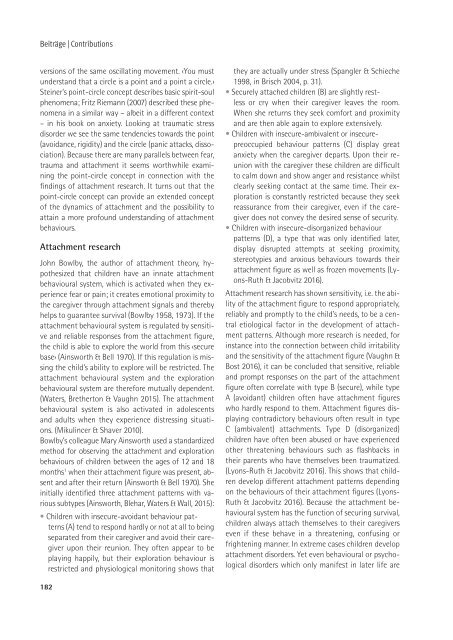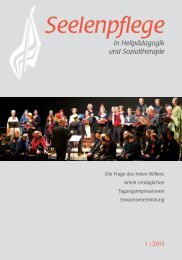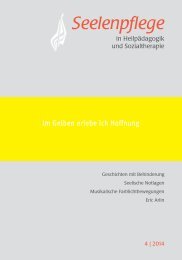Seelenpflege 2016-3-4 Spezial
Seelenpflege 2016-3-4 Spezial
Seelenpflege 2016-3-4 Spezial
You also want an ePaper? Increase the reach of your titles
YUMPU automatically turns print PDFs into web optimized ePapers that Google loves.
Beiträge | Contributions<br />
versions of the same oscillating movement. ‹You must<br />
understand that a circle is a point and a point a circle.›<br />
Steiner’s point-circle concept describes basic spirit-soul<br />
phenomena; Fritz Riemann (2007) described these phenomena<br />
in a similar way – albeit in a different context<br />
– in his book on anxiety. Looking at traumatic stress<br />
disorder we see the same tendencies towards the point<br />
(avoidance, rigidity) and the circle (panic attacks, dissociation).<br />
Because there are many parallels between fear,<br />
trauma and attachment it seems worthwhile examining<br />
the point-circle concept in connection with the<br />
findings of attachment research. It turns out that the<br />
point-circle concept can provide an extended concept<br />
of the dynamics of attachment and the possibility to<br />
attain a more profound understanding of attachment<br />
behaviours.<br />
Attachment research<br />
John Bowlby, the author of attachment theory, hypothesized<br />
that children have an innate attachment<br />
behavioural system, which is activated when they experience<br />
fear or pain; it creates emotional proximity to<br />
the caregiver through attachment signals and thereby<br />
helps to guarantee survival (Bowlby 1958, 1973). If the<br />
attachment behavioural system is regulated by sensitive<br />
and reliable responses from the attachment figure,<br />
the child is able to explore the world from this ‹secure<br />
base› (Ainsworth & Bell 1970). If this regulation is missing<br />
the child’s ability to explore will be restricted. The<br />
attachment behavioural system and the exploration<br />
behavioural system are therefore mutually dependent.<br />
(Waters, Bretherton & Vaughn 2015). The attachment<br />
behavioural system is also activated in adolescents<br />
and adults when they experience distressing situations.<br />
(Mikulincer & Shaver 2010).<br />
Bowlby’s colleague Mary Ainsworth used a standardized<br />
method for observing the attachment and exploration<br />
behaviours of children between the ages of 12 and 18<br />
months 1 when their attachment figure was present, absent<br />
and after their return (Ainsworth & Bell 1970). She<br />
initially identified three attachment patterns with various<br />
subtypes (Ainsworth, Blehar, Waters & Wall, 2015):<br />
• Children with insecure-avoidant behaviour patterns<br />
(A) tend to respond hardly or not at all to being<br />
separated from their caregiver and avoid their caregiver<br />
upon their reunion. They often appear to be<br />
playing happily, but their exploration behaviour is<br />
restricted and physiological monitoring shows that<br />
they are actually under stress (Spangler & Schieche<br />
1998, in Brisch 2004, p. 31).<br />
• Securely attached children (B) are slightly restless<br />
or cry when their caregiver leaves the room.<br />
When she returns they seek comfort and proximity<br />
and are then able again to explore extensively.<br />
• Children with insecure-ambivalent or insecurepreoccupied<br />
behaviour patterns (C) display great<br />
anxiety when the caregiver departs. Upon their reunion<br />
with the caregiver these children are difficult<br />
to calm down and show anger and resistance whilst<br />
clearly seeking contact at the same time. Their exploration<br />
is constantly restricted because they seek<br />
reassurance from their caregiver, even if the caregiver<br />
does not convey the desired sense of security.<br />
• Children with insecure-disorganized behaviour<br />
patterns (D), a type that was only identified later,<br />
display disrupted attempts at seeking proximity,<br />
stereotypies and anxious behaviours towards their<br />
attachment figure as well as frozen movements (Lyons-Ruth<br />
& Jacobvitz <strong>2016</strong>).<br />
Attachment research has shown sensitivity, i.e. the ability<br />
of the attachment figure to respond appropriately,<br />
reliably and promptly to the child’s needs, to be a central<br />
etiological factor in the development of attachment<br />
patterns. Although more research is needed, for<br />
instance into the connection between child irritability<br />
and the sensitivity of the attachment figure (Vaughn &<br />
Bost <strong>2016</strong>), it can be concluded that sensitive, reliable<br />
and prompt responses on the part of the attachment<br />
figure often correlate with type B (secure), while type<br />
A (avoidant) children often have attachment figures<br />
who hardly respond to them. Attachment figures displaying<br />
contradictory behaviours often result in type<br />
C (ambivalent) attachments. Type D (disorganized)<br />
children have often been abused or have experienced<br />
other threatening behaviours such as flashbacks in<br />
their parents who have themselves been traumatized.<br />
(Lyons-Ruth & Jacobvitz <strong>2016</strong>). This shows that children<br />
develop different attachment patterns depending<br />
on the behaviours of their attachment figures (Lyons-<br />
Ruth & Jacobvitz <strong>2016</strong>). Because the attachment behavioural<br />
system has the function of securing survival,<br />
children always attach themselves to their caregivers<br />
even if these behave in a threatening, confusing or<br />
frightening manner. In extreme cases children develop<br />
attachment disorders. Yet even behavioural or psychological<br />
disorders which only manifest in later life are<br />
182






